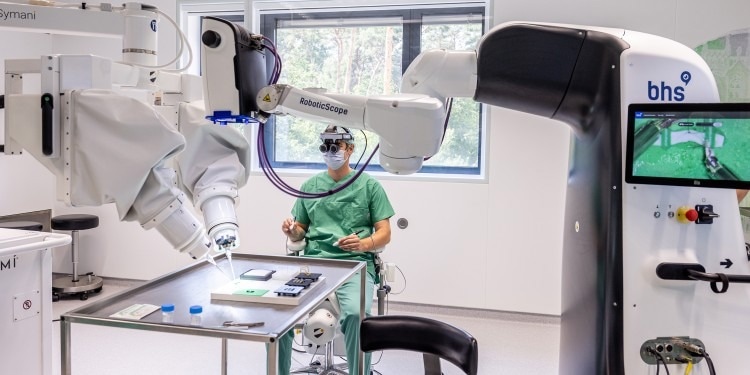Surgeons in Münster have employed a novel operating technique to advance the use of medical digitalization in operating rooms.
 Dr. Maximilian Kückelhaus presents the new method in a dry-run training session. The operations robot (right) is networked with a robotic microscope (left). Image Credit: ©WWU–Peter Leßmann.
Dr. Maximilian Kückelhaus presents the new method in a dry-run training session. The operations robot (right) is networked with a robotic microscope (left). Image Credit: ©WWU–Peter Leßmann.
The first fully robot-supported microsurgical procedures on humans were performed by a team led by researchers Dr Maximilian Kückelhaus and Prof. Tobias Hirsch from the Centre for Musculoskeletal Medicine at the University of Münster. This is a significant achievement for robotic microsurgery not just in Münster but globally in terms of medicine and science.
The doctors employed a novel operating technique in which a robotic microscope is networked with a new type of operations robot created specifically for microsurgery. With this method, it is possible to remove the operating surgeon entirely from the operating room. In conjunction with Münster University Hospital and Hornheide Specialist Clinic, robotic clinical research is carried out.
This technique has been employed by the professionals for around two months. Five procedures have been completed successfully so far, and many more are planned.
This new method for operations enables us to work with a much higher degree of delicacy and precision than is possible with conventional operating techniques. As a result, less tissue is destroyed and patients recover faster.
Dr Maximilian Kückelhaus, Centre for Musculoskeletal Medicine, University of Münster
The procedure is used by experts, for instance, on patients with breast cancer who require intricate breast reconstructions or on patients who need tissue transplants following accidents. Microsurgeons can, for instance, reattach the smallest anatomical structures, such as blood vessels, nerves, or lymphatic vessels, which frequently have a diameter of only 0.3 mm, with the help of the robot and the robotic microscope.
The Symani Surgical System mimics human hand movements during surgery using an electromagnetic field and joysticks. The tiny instruments used by the robot to perform the operating surgeon’s movements have been shrunk by up to 20 times. This eliminates any hand trembling that might have existed.
The operation robot is attached to a robotic microscope, which displays the region being worked on two high-resolution monitors using a so-called 3D augmented reality headset. This headset has a pair of binoculars that can mix real-world and virtual data.
Through the recording and transmission of the surgeon’s head motions to the robot, even complex viewing angles of the surgical site are made possible. The operating surgeon can also use the robot to access a number of menus and carry out tasks without having to use their hands.
The new technology also allows operating surgeons to take a relaxing stance, as opposed to the difficult posture they would otherwise need to adopt for several hours during operations.
As we can now operate on patients in a remote fashion, we have much better ergonomics. This in turn protects us from fatigue, and that means that our concentration can be maintained over a period of many hours. In initial studies involving the systems, before they were used in operations, we were already able to confirm the positive effects on the quality of operations and on ergonomics.
Tobias Hirsch, Chair, Plastic Surgery, University of Münster
The doctors were able to show that, when utilizing the robotic system, the learning curve, the handling of the instruments, and the ergonomics all indicated an advancement over traditional operating approaches during training with students and experienced microsurgeons.
Maximilian Kückelhaus and Tobias Hirsch will carry out further procedures over the coming weeks and months, gathering data to analyze in research projects. Improvements to the efficiency of operations and ergonomics are particularly significant issues that must be addressed.
Our hope is that with this new method we can not only perform operations with a greater degree of precision and safety—but also, in the case of the tiniest structures, go beyond limits imposed by the human body.
Dr Maximilian Kückelhaus, Centre for Musculoskeletal Medicine, University of Münster
“Not having to be at the operating table can also mean that one day the operating surgeon will no longer have to be physically present. An expert might be able to perform special operations at any one of several locations—without having to travel and be there in person,” states Maximilian Kückelhaus, envisioning the future.
Maximilian Kückelhaus received funds from the European Union’s “Recovery Assistance for Cohesion and the Territories of Europe” initiative for the creation and clinical testing of this approach.